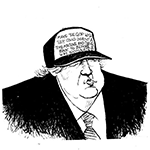Marcus Hayes: Oakmont is again magnificent and so is J.J. Spaun as the US Open host and Pennsylvania courses keep flexing
Published in Golf
OAKMONT, Pa. — Through it all, looming large and nasty and insurmountable, there was the golf course.
Oakmont Country Club hosted its record 10th U.S. Open. As ever, it did not disappoint.
This is the place that, in 1962, gave the first of Jack Nicklaus’ record 18 major wins, and, 11 years later, Johnny Miller’s record 63 to win on Sunday — the greatest round ever played in a major, if not the greatest round in the history of golf.
The place itself overshadowed the pettiness and bickering and complaining, the club-throwing and tee-marker-smashing and the dire weather forecasting, and, of course, the first-time winning. In its first nine Opens, Oakmont saw seven players win their first major. On Sunday, J.J. Spaun and Robert McIntyre charged through a rain-soaked second nine to make it certain there would be an eighth.
Spaun, who began the day at 3-under and dropped five shots in the first six holes, rallied. He birdied No. 17 for a one-stroke lead over McIntyre, whose 3-under back nine left him 1-over, then dropped a 65-foot birdie putt that punctuated his two-shot lead. At 1-under, Spaun was the only player to finish under par. He had one PGA Tour win before he tamed the beast. The hardy folks who waited out nearly two hours of rain delay rewarded him with full throat.
He’d been a model father on Father’s Day, running to the drugstore at 3 a.m. One of his daughters had a stomach bug and was “vomiting all night long.” Little wonder he started so poorly.
Distraction on Oakmont can be deadly.
Always, every day, Oakmont was the story. It remains the merciless beast it was when it came into being 121 years ago, the project of steel magnate H.C. Fownes, who, upon receiving the diagnosis at the age of 39 that he had a short time to live, sold his business to Andrew Carnegie and sought to live out his remaining time in pursuit of a better golf game.
The diagnosis was wrong. Fownes lived 40 more years, but golf was blessed for the misdiagnosis, whose result is America’s most consistently difficult, indisputably fair test of elite golf. It has earned the honor of hosting at least three more Opens, beginning in 2033.
It now is the centerpiece of a U.S. Open rotation that includes Merion Golf Club outside of Philadelphia, Oakmont’s wicked little sister, which in 2030 will host its sixth Open, then two more 10 years apart. This has turned into a golden era for golf in the Commonwealth. Philadelphia Cricket Club last month hosted the Truist Championship, one of the PGA Tour’s eight elevated events. Aronimink Golf Club, just west of Philly, hosted the BMW Championship, a playoff event, in 2018, and will host the PGA Championship next year.
The other three courses are wonderful.
None of them is Oakmont.
Rare excellence
When Miller shot 63, which remains the course record here 42 years later, it was like breaking the 100-meter dash mark, at sea level, into a 20-mph headwind. It was the best round in U.S. Open history, and remained unsurpassed for 50 years. It has been bettered just twice, with far better equipment wielded by far better fields.
“In the last round, it was, like, my guardian angel out there said, ‘OK, we’re going to put together a perfect round of golf,’ ” Miller said here Saturday. “And it was literally a perfect round of golf.”
Nicklaus won four U.S. Opens, which annually is the toughest test on tour. Greens at Oakmont this week ran up to a 15, which is like putting on a pool table, with rough trimmed, to 5 1/2 inches. Yes, trimmed.
Scottie Scheffler, in his 144th week as the World No. 1, coming off his third major-championship win, called it, “the hardest golf course I’ve ever played.”
Asked about the 5 1/2-hour rounds with the full, struggling 156-man field on site Thursday and Friday, he replied, “It just takes time to hit that many golf shots.” He hung in and finished 4-over.
Adam Scott, playing in his 96th consecutive major and his third at Oakmont — he missed the cut in 2007 and finished tied for 18th in 2016 — had this assessment after eight bogeys in his first two rounds:
“It wasn’t blow-your-brains-out hard yet, but it was getting there,“ Scott told SiriusXM after finishing Friday at even par, which tied for fourth. ”The gun was loaded.”
Scott, 44, was tied for second after three rounds, one shot behind Burns, who somehow laid a 5-under 65 on the field Friday. Burns’ secret: “I didn’t really think of much of a score. Like I said, the golf course is really too difficult to try to figure out what’s a good score and what’s not. You’re really just going shot-by-shot.”
They were the final group Sunday, but, after a rain delay, each collapsed on the second nine.
Viktor Hovland navigated a bad break in a bunker on the second hole of his second round, settled, and finished the day 1-under.
“I feel like a couple times, if it would have happened at another tournament, for example, I could have potentially lost my mind there a little bit,” said Hovland, who finished in third place, at 2-over.
Gene Sarazen, whose 1922 PGA Championship win here was his second of seven major titles, once said Oakmont has “all the charm of a sock to the head.”
Nicklaus thrived at U.S. Opens at Oakmont: Win, T-4, T-43.
“I loved USGA setups,” said Nicklaus, who says he three-putted here just once. "I knew that you had to drive the ball straight. I knew that putting was going to be a premium on this golf course."
And so, as ever, it was.
Evolution
The course has undergone more face-lifts than Joan Rivers, most recently two years ago by Gil Hanse, indefatigable Eagles fan and golf architect who works his restoration magic out of his firm in suburban Philadelphia. By the time Hanse got his hands on it, more than 15,000 trees had been removed, so he generally tried to return the property to its 1927 profile.
He lowered the sides of greens. He added two rows to the Church Pew bunkers that separate Nos. 3 and 4; they now number 13, and it’s 109 yards long and 42 yards wide. Hanse generally returned the course to its sadistic, deceptive essence. The Fownes, father and son, used to watch players miss fairways, and if the player was able to recover too easily, they would insert a new bunker.
The course’s caretakers today share that sadism.
The players’ main complaint concerned the shagginess of the rough around the fairway bunkers. If the ball snags in that rough it often forces a short recovery shot, whereas a ball in the bunker often allows a player a chance to get close to the green, if not all the way there.
The other issue was the par-3 eighth hole played 301 yards Sunday, the longest par-3 in tour history, and described as “ridiculous” by Collin Morikawa.
He’s got a point. Half of the 179 ranked tour players don’t hit their driver an average of 301 yards. Almost none of them made it to the weekend.
But then, Oakmont was not created for the average golfer. It was created to challenge the greatest golfers.
It is not America’s best golf course; that’s Pine Valley, in New Jersey. It’s not America’s most beautiful golf course; that’s probably Pebble Beach. In fact, Oakmont, as its name implies, is homely and plain and stolid, just like its spiritual twin in Scotland, Carnoustie. Entering the week, Carnoustie was the second-most difficult course on which majors have been regularly played in the past 80 years, with a scoring average of 75.4. Oakmont was first, at 75.9.
This week, with inviting fairways and rain-softened greens that were as receptive as the kindhearted folks here in Allegheny County, the average score was almost a shot and a half lower.
Not that it was easy. It’s never easy.
Like Augusta National, it’s impossible to appreciate the texture of a course like this without standing on it, particularly the way the land slopes to push good shots from the paradise of the fairway to the purgatory of its edges. The subtleties and speeds of greens don’t surface until after approach shots land or putts are hit. Only the rough and bunkers look appropriately impossible on TV.
It is of no consolation to the players that, unlike most venues, the conditions here don’t change much. Oakmont plays nearly as difficult for the amateur membership as it does for the world’s best pros.
Before he missed the cut, defending champion and LIV star Bryson DeChambeau said the average 18-handicapper, from the 7,300-yard tournament tees, facing U.S. Open conditions on this par-70 track, would shoot no better than 200.
He’s right.
But oh, what a memorable 200 it would be.
©2025 The Philadelphia Inquirer. Visit inquirer.com. Distributed by Tribune Content Agency, LLC.







Comments